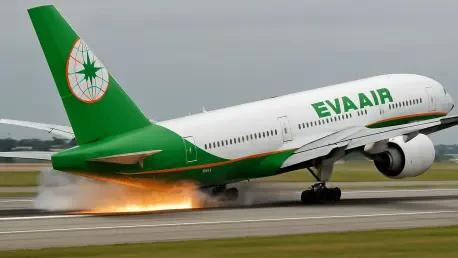Imagine a routine flight turning into a moment of concern as an aircraft’s tail scrapes the runway during a critical maneuver, raising questions about safety and operational precision that resonate throughout the aviation community. On October 4, 2025, an EVA Air Boeing 787-9 encountered just such an incident at Taipei Songshan Airport during a go-around procedure. Though no injuries occurred, the event has sparked widespread discussion among aviation professionals, safety experts, and regulatory bodies. This roundup gathers diverse perspectives, tips, and analyses from across the industry to unpack what happened, explore differing opinions on causes and responses, and highlight lessons for the future of air travel safety. The goal is to provide a comprehensive view of this rare but significant occurrence and its implications for airlines and passengers alike.
Exploring the Incident Through Multiple Lenses
What Happened and Initial Reactions
The tail strike incident involving EVA Air’s Boeing 787-9, registered as B-17881, occurred during a low-altitude go-around at Taipei Songshan Airport. As the aircraft aborted its landing, the main landing gear briefly touched the runway, causing the tail section to scrape the surface. Minor damage was reported to the tail strike protection system, a critical feature designed to absorb such impacts. After climbing to 3,000 feet and circling, the pilots executed a safe landing within 15 minutes. Industry observers noted the controlled response, emphasizing that the absence of injuries was a testament to robust safety protocols.
Aviation safety analysts have praised the immediate actions taken post-incident, with many highlighting the decision to ground the aircraft for a detailed inspection. Some industry voices suggest that this swift grounding reflects a cautious approach, prioritizing thorough checks over operational haste. However, others argue that such incidents, while minor, can disrupt flight schedules and raise questions about whether immediate grounding is always necessary for superficial damage. This split in opinion sets the stage for deeper analysis of procedural norms.
Theories on Causes: Pilot Error, Weather, or Design?
Differing views emerge when dissecting the potential causes of the tail strike. A segment of aviation consultants points to the possibility of pilot error, suggesting that misjudgment during the go-around maneuver at low altitude could have contributed to the runway contact. They stress that go-around procedures, though standard, demand precise execution under pressure, especially at an airport like Taipei Songshan, constrained by urban surroundings.
In contrast, another group of industry commentators focuses on external factors, such as adverse weather conditions or sudden changes in wind patterns, which might have influenced the aircraft’s approach. They argue that environmental variables often play an underappreciated role in such events and call for better real-time weather data integration into cockpit systems. Meanwhile, a smaller faction raises concerns about aircraft design, noting that the Boeing 787-9’s fuselage length could increase tail strike risks if pitch angles are not meticulously managed, prompting debates on whether design adjustments are warranted.
These varied perspectives underscore the complexity of pinpointing a single cause. Ongoing investigations by the Taiwanese Civil Aviation Administration (CAA) are expected to provide clarity, but the diversity of opinions highlights the multifaceted nature of aviation incidents. It also emphasizes the need for comprehensive data collection to address all possible contributing factors without premature conclusions.
Industry Tips and Best Practices Post-Incident
EVA Air’s Response: A Model of Transparency?
Feedback on EVA Air’s handling of the aftermath reveals a largely positive consensus among safety experts. The airline’s decision to conduct a full inspection, replace the damaged tail strike protection system, and coordinate closely with regulatory bodies has been commended as a benchmark for crisis management. Many in the industry view this transparency as a critical factor in maintaining passenger trust, especially after an event that could have raised public alarm despite its minor impact.
However, some operational analysts caution that while transparency is vital, airlines must balance it with efficient recovery to minimize downtime. They suggest that EVA Air could have explored expedited inspection protocols if initial assessments confirmed negligible structural damage. This critique points to a broader tension between safety-first approaches and the economic pressures of keeping fleets active, a balance that remains a topic of hot debate among airline management professionals.
Mitigating Tail Strike Risks: Training and Technology
Insights from training specialists emphasize the importance of enhanced simulator programs tailored to go-around scenarios, particularly for aircraft like the Boeing 787-9 with specific design vulnerabilities. They recommend that airlines invest in regular, scenario-based drills to sharpen pilot reflexes during critical maneuvers, especially at challenging airports with tight operational margins. Such proactive measures, they argue, could significantly reduce the likelihood of similar incidents.
On the technological front, aircraft design engineers advocate for advancements in tail strike prevention systems, suggesting that real-time pitch angle alerts could provide pilots with instant feedback during high-risk phases of flight. Yet, a contrasting opinion from operational safety advisors warns against over-reliance on technology, insisting that human judgment and situational awareness remain irreplaceable. This push-and-pull between tech solutions and skill development reflects an ongoing dialogue about the best path forward for risk mitigation.
A third angle comes from regulatory consultants who propose stricter guidelines for monitoring aircraft-specific risks during critical flight phases. They argue that updated protocols, informed by data from incidents like this one, could standardize prevention across the industry. Combining training, technology, and regulation, these tips offer a holistic framework for airlines aiming to bolster their safety measures in the wake of such events.
Broader Implications for Aviation Safety
Public Perception and Trust in Air Travel
Aviation branding experts weigh in on how incidents like the tail strike affect public confidence, noting that EVA Air’s open communication played a pivotal role in mitigating potential backlash. They compare this to other minor tail strike cases over recent years, observing that consistent, clear messaging from airlines often reassures travelers more effectively than silence or delayed updates. This perspective highlights the importance of strategic communication in preserving an airline’s reputation.
On the flip side, consumer behavior analysts suggest that repeated exposure to even minor aviation incidents could gradually erode trust among less frequent flyers. They advise airlines to not only address incidents transparently but also proactively educate passengers about safety features and protocols to counter any lingering doubts. This dual approach, blending response with education, is seen as a way to maintain loyalty in a competitive market.
Lessons for the Industry: A Collective Call to Action
Safety advocates across the board agree that tail strikes, though rare, serve as valuable learning opportunities for the aviation sector. Many urge airlines to share detailed post-incident reports with industry peers to foster collective improvement, rather than treating such events as isolated cases. This collaborative mindset, they believe, could accelerate the adoption of best practices and prevent recurrence on a wider scale.
Differing slightly, some regulatory voices push for more stringent oversight, arguing that voluntary sharing may not suffice for systemic change. They propose mandatory reporting frameworks and periodic safety audits focused on tail strike risks, especially for newer aircraft models. This divergence in approach—collaboration versus regulation—illustrates the varied strategies being considered to elevate safety standards over the coming years, from 2025 onward.
Reflecting on Key Takeaways and Next Steps
Looking back, the EVA Air Boeing 787-9 tail strike incident at Taipei Songshan Airport sparked a rich array of discussions, from dissecting potential causes to evaluating the airline’s response and broader safety implications. Industry perspectives converged on the value of transparency and rigorous inspections, while opinions differed on the balance between technology and training as preventive tools. The event also underscored the delicate interplay between maintaining public trust and managing operational efficiency.
Moving forward, airlines are encouraged to prioritize enhanced simulator training for complex maneuvers and invest in advanced warning systems to complement pilot skills. Regulatory bodies might consider tightening guidelines around tail strike prevention, ensuring that data from such incidents informs future policies. For passengers, staying informed about airline safety practices can offer reassurance, while industry stakeholders should explore collaborative platforms to share insights and solutions. These steps, inspired by the lessons of this incident, pave the way for a safer aviation landscape in the years ahead.









